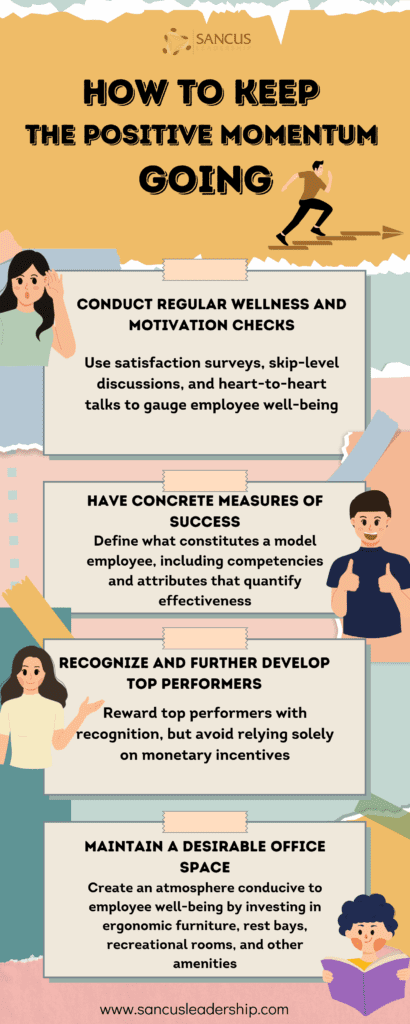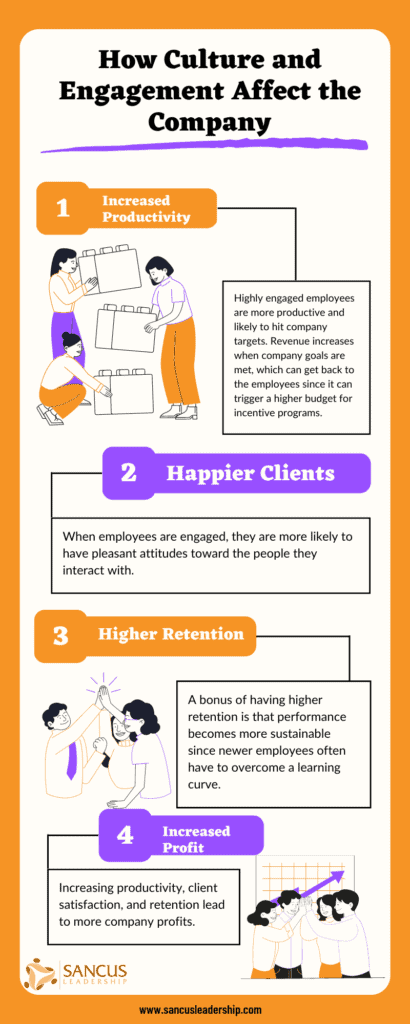If you are lucky, you (like me) have worked on a team with highly engaged employees and have felt how exciting it is when everyone puts their best effort in. Since motivated team members are rare, it is more likely that most of your experience will have been with a disengaged workforce just showing up for their paycheck. So how do we fix low employee engagement?
To build a highly engaged employee culture, ensure each person knows how valuable they are to the company. Everyone on the team must also share the same vision and understand their importance in making it a reality. The team leader has to sell the vision and guide the team toward it.
Keep reading if you want to keep your employees driven and highly motivated. This article will discuss my perspective on building company culture, essential leadership qualities, and the immensely positive results I have seen in organizations and teams.
How To Build Company Culture

It’s wishful thinking to try and change a company or a team’s culture overnight, but that does not mean that a good leader cannot influence or shape it to become what they want it to be.
Forming a work environment where employees feel valued and are highly motivated may take time, but a compassionate leader can achieve it with urgency and consistency.
Imagine a working atmosphere where employees are in their element and eager to meet company goals. Leaders can spend more time developing talent in such an environment rather than delegating or correcting behavior.
Any workplace can get caught up in the motions where employees are overwhelmed with tasks, and success is purely based on the company’s bottom line. This type of working environment is a recipe for toxicity, and if unaddressed, meeting company goals will be a constant struggle.
The problem usually stems from a lack of communication where employees robotically accomplish tasks set for themselves instead of understanding that they are part of a team.
… employees robotically accomplish tasks set for themselves instead of understanding that they are part of a team.
Having an “every man for himself” mindset can foster unhealthy competition or, at the very least, cause some employees to feel undervalued and merely work for their paychecks.
When you have a team where the members work to get paid, you would be remiss to expect anything more than the bare minimum because they will get paid regardless.
It has also been proven repeatedly since the 70s that production only increases as a function of the salary if the work is uncomplicated and easily repeatable.
Most jobs today include problem-solving and creation; in Daniel Kahneman’s book called thinking fast and slow, he explains how monetary incentives actually inhibit performance; it’s definitely worth a read!
Fortunately, changing the culture and increasing employee engagement is not rocket science; leaders with a genuine interest in their people can do it.
Inspire Passion in Your Team With the Company’s Vision

Every company should have a vision, and each team should have one. A company vision is a statement that encapsulates the company’s purpose and long-term goals.
Even if you’re managing a small group, getting each member to live and breathe the vision can help provide much-needed guidance in the right direction.
Even if you’re managing a small group, getting each member to live and breathe the vision can help provide much-needed guidance in the right direction.
And here’s the $1,000,000 tip: if you want to make your life easy as a business owner or team leader, you need to recruit people who are passionate about the company’s why.
If you hire people who believe in the business’s more important mission, people will stay because they align as individuals with the purpose, not because of the paycheck.
What Makes a Good Vision?

Your vision for your team should be concise and easy to remember yet impactful to your day-to-day operations. A good picture can set the tone for decision-making and the customer interface.
Here at the Sancus Leadership, our vision is to “Train the world’s most effective small team leaders.”
Here at the Sancus Leadership, our vision is to “Train the world’s most effective small team leaders.”
More importantly, it fosters teamwork and camaraderie by establishing a common goal beyond numbers, which each team member can aspire to achieve.
Disneyland’s vision statement, “To be the happiest place on Earth,” is short and straightforward. Yet, it clearly defines the company’s purpose while serving as an invaluable mantra that impacts how customers and everyone within the organization are treated.
Regardless of your industry, you can develop a vision that applies to your team. But no matter how good your vision statement is, it will be just words on paper if each team member needs help understanding and aligning with it.
Inculcate your team into the company vision by discussing the following:
- How the vision aligns with company goals and the role they play in achieving it
- How exceeding the company’s goals will benefit the employees
- How it makes life easier for everyone
Defining Roles and Setting Expectations

Letting your team know how the vision aligns with the company’s goals communicates that the company has a more profound purpose besides making money. But aside from putting a vision in place, you need to set clear expectations as to what role each team member plays in making the vision come to fruition.
As a leader, you must “draw a line” between the company’s purpose and the individual’s daily tasks. If they can understand why solving this task leads to fulfilling the company’s higher mission, it is almost impossible for engagement not to go up.
You also need to discuss your role as their leader. Specify how you will equip each team member to fulfill their roles and what kind of support they should expect from you to help them progress.
You must execute your role as promised because you can only hold your team accountable if you live up to your part of the bargain.
I don’t think that management styles where those in authority merely delegate and call people out work as well as they used to do (if they ever did). Discussing metrics and taking punitive action in any organization is sometimes inevitable, but it can also make people feel like they are machines in a factory.
While quantifiable measures are essential in any business, humanizing what the company strives to achieve through a vision is just as crucial.
Here’s another million-dollar tip for ya: when someone makes a mistake, instead of assuming malice or incompetence, believe that something you don’t know affects your employee’s performance.
This will put you in a mental state of Investigation rather than blaming. Your people will feel like you care about them and the task.
Emphasizing Value and Career Growth
Once your team understands how the vision will help the company reach its goals, it is time for you to emphasize the benefits of being part of a successful organization. Discuss the career opportunities that lie ahead, given the company’s potential growth, and how critical everyone’s current role is in paving the way for success.
And if you realize there are no benefits to your employees, guess what? You better create some fast because why otherwise should they stay?
If someone is only giving, they will become a martyr sooner or later, and martyrdom breeds bitterness. There must be advantages to the individual if you want them to engage with work fully.
There must be advantages to the individual if you want them to fully engage with work.
Making the team members realize the impact they have on a bigger scale instills value while driving more accountability. The prospect of career growth will also motivate some to perform better while encouraging them to have long-term aspirations within the company.
No More Micro-Managing
The byproduct of establishing a clear vision for your team is a culture where each member is driven by purpose rather than the often mundane and tedious tasks.
When your team members are purpose-driven, you can stop macro-managing since the team understands what leads to success and can use their judgment to decide how things should be done.
You’ll also find your team becoming more empowered and engaged as micro-managing disappears.
Show Them How To Get There

A good vision is only worthwhile if your team is equipped to execute what needs to be done to make it happen. You can think of the vision as a destination and the required work as the journey. No matter how appealing the goal is, your team will only get there if they know how.
As the leader, it’s your job to show them the way.
Not everyone will have the innate abilities needed to be standout performers; a fair amount of intervention is usually necessary to build the essential skills.
But it is even more critical to continue supporting those who are naturally good at what they do; the Pareto distribution tells us that 20% of the employees do 80% of the work.
One way to look at your role as a leader is to be an obstacle remover. Great leaders are excellent at removing obstacles before the team can notice them. This means the team can operate at the highest speed possible.
Great leaders are excellent at removing obstacles before the team has a chance to notice them.
Still, it’s important to remember this step, as achieving a highly engaged employee culture is far easier when everyone feels they have something to offer.
Training
Training is essential to ensuring your team can perform what’s required. However, it’s unfair to expect anyone to become a master of a trade by merely reading a manual. Benjamin Franklin once said, “Tell me, and I’ll forget. Teach me, and I may remember. Involve me, and I learn.”
Many organizations obsess over training scores and assessments. While training is important, how you go about it is equally important.
Training programs should always be more practical than theoretical. It isn’t enough to tell people what needs to be done and how to do it. There has to be a comfortable environment where trainees can put what they’ve learned into practice, even before being assessed.
Coaching
Expertise can be formed through exposure and experience, but that should not negate the need for continuous coaching and development. This is why the best athletes continue to be coached and trained throughout their careers.
In my experience, coaching is best used as a supplement to regular training programs, not a replacement.
Consider a weekly meeting with an employee. Of course, cutting out enough time can be difficult, but the rewards are substantial for morale and growth in the long term.
These types of coaching sessions with your people provide you with an opportunity to commend good behaviors or address any issues that may be hindering performance.
These are a few things to cover during a one-on-one with an employee:
- Isolate the most impacting behavior leading to poor performance – work on it until it is just good enough.
- Isolate the most impacting behavior leading to great performance – build that strength as much as you can; this determines whether your team will win or lose.
- Identify the root cause and if it is a skill or will issue.
- Agree on an action plan to address the issue based on the root cause.
- Lay out measures of success and gain commitment in terms of what the employee is expected to achieve – make sure the employee is convinced that they can do it.
- Remind the employee how valuable they are to the organization and how critical their role is to the company’s success (if they are).
Support
Aside from weekly interactions with each team member, it would be best to create an environment where support is felt and help is accessible.
The manager must monitor performance (not people!) and ensure that resources and systems are in place to help each member carry out their duties effectively.
A good leader will constantly seek feedback from the team to identify areas for improvement, which can either improve output or make life easier for the employees. Team building activities, in and out of the office, can help improve relationships, but the key to forming healthy relationships within the group starts with the leader.
A good leader will constantly seek feedback from the team to identify areas for improvement, which can either improve output or make life easier for the employees.
Maintaining open lines of communication is a critical aspect of team dynamics, so the leader has to be approachable and open to feedback if they want their employees to follow suit.
| Things to Build a Company Culture | Description |
| Training | The importance of practical training programs that involve trainees and allow them to apply what they’ve learned in a comfortable environment. It suggests that training should not just be theoretical and that it’s essential to involve employees in the learning process. |
| Coaching | The importance of continuous coaching and development for employees, even after they’ve completed a training program. It suggests that coaching should be used as a supplement to regular training programs and that regular check-ins with employees can be beneficial for their growth and development. |
| Support | The need for support and resources to help employees carry out their duties effectively. It suggests that a good leader should monitor performance and seek feedback from their team to identify areas for improvement. It also mentions the importance of team-building activities and healthy relationships within the group. |
Sustaining the Momentum
It’s one thing to create excitement in the workplace, but it’s another thing to sustain momentum. Just because you’ve managed to create a pool of highly engaged employees does not mean that they will remain motivated without further intervention; they most likely will not.
Here are some pointers on how to keep the positive momentum going:
- Conduct regular wellness and motivation checks
- Have concrete measures of success
- Recognize and further develop top performers
- Maintain a desirable office space

Wellness Checks
As much as you encourage open lines of communication, certain team members might not be comfortable voicing their concerns, so it is essential to have platforms for measuring employee wellness.
Satisfaction surveys and skip-level discussions are effective venues for gauging everyone’s well-being.
However, having a heart-to-heart talk with your employees should always be your default way of leading.
However, having a heart-to-heart talk with your employees should always be your default way of leading.
Concrete Measures of Success
It is crucial to define what constitutes a model employee. Aside from having numbers or metrics that showcase performance, you should be very clear about the competencies and attributes that quantify effectiveness.
Giving the employees a clear picture of what “good” looks like helps them understand how you define success. It also alleviates any doubts of favoritism or politics within the team when someone receives recognition or gets a promotion because the competencies are clearly outlined.
Rewards and Recognition
Awarding and commending employees are crucial to sustaining positive momentum. Rewards give your top performers the recognition they deserve while inspiring the rest of the team to improve their performance.
Use this as an add-on and not as your main incentive because, as we learned from decades of behavioral research, monetary incentives don’t really work that well in the long term.
A Desirable Office Space
Supporting a team isn’t limited to verbal communication; creating an atmosphere conducive to employee well-being also goes a long way. Making the office space more desirable with ergonomic furniture, rest bays, and recreational rooms may seem like an added cost, but the return on investment is invaluable. Even a simple coffee machine with daily fresh coffee can work wonders.
The aim is to make the office a place where people enjoy spending time and not feel the need to leave as quickly as possible; this will also make people less prone to ask for remote positions.
How Culture and Engagement Affect the Company

Transforming office culture to promote engagement may seem like a lot of work, but managing a team of unmotivated employees can be even more exhausting. Getting company culture right makes everyone’s life easier and has dramatic effects from a business standpoint.
Increased Productivity
Highly engaged employees are more productive and likely to hit company targets. Revenue increases when company goals are met, which can get back to the employees since it can trigger a higher budget for incentive programs.
Happier Clients
Company culture also has a significant influence on how employees treat customers. When employees are engaged, they are more likely to have pleasant attitudes toward the people they interact with. Having happier customers often means more business for the company.
Higher Retention
Another benefit of having a highly engaged team is lower attrition, allowing the company to save a fortune on recruiting and training costs. A bonus of having higher retention is that performance becomes more sustainable since newer employees often have to overcome a learning curve.
Increased Profit
Increasing productivity, client satisfaction, and retention lead to more company profits. So, even if you shift your focus from the company’s bottom line to employee engagement, the results can still be financially beneficial.

Conclusion
You can build a company culture of highly engaged employees by setting a vision and ensuring your team is equipped to make it a reality. Still, no matter how motivated and self-sustaining your team becomes, a role as a manager will remain crucial to sustaining momentum and good performance.
Changing company culture is no walk in the park. It requires considerable expenditure, but the benefits will always be worth it.



